So I’m on the Instagram, when there on the page of forgottenmadness_la, was this post. FMLA noted that the nifty image was part of a LIFE magazine feature titled “Ugly America,” shot by Walter Sanders. I flew immediately to the greater collection, archived at Google Arts & Culture, here. I am deeply indebted to FMLA for hipping me to this hoard, so, please go over and follow their IG page; it’s great work.
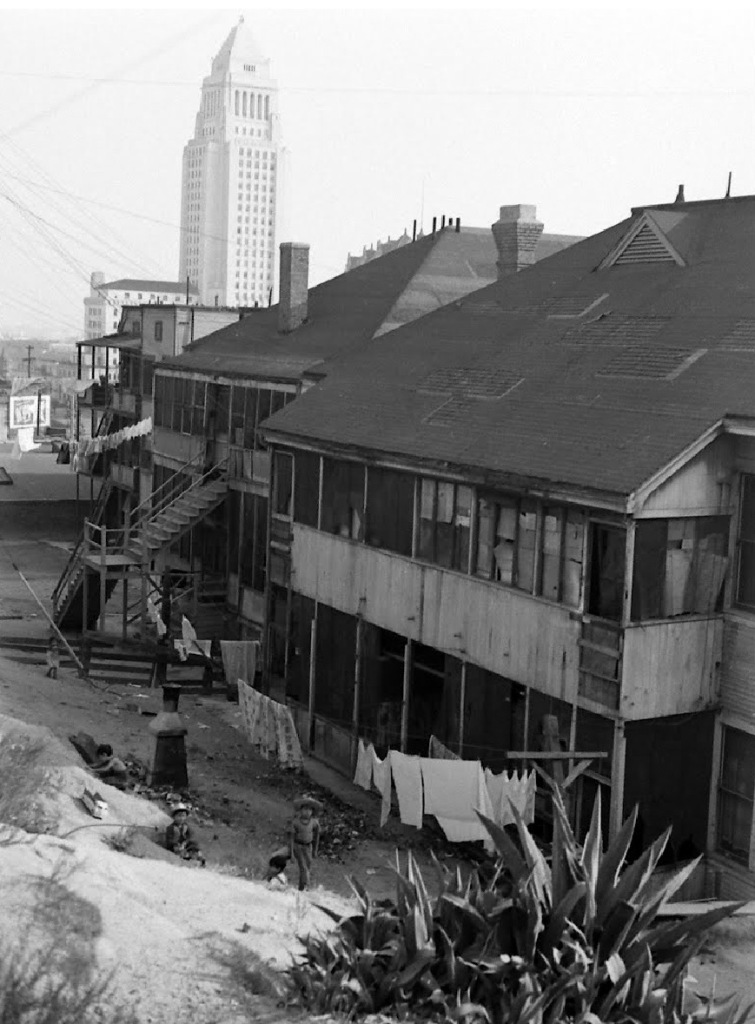
From what I can tell, none of Sanders’ images from this shoot, nor any “Ugly America” feature, ever actually ran in LIFE magazine. I certainly would like to read said piece, so I may see what actual arguments LIFE attempted to make.
Basically, Sanders went to Los Angeles and San Francisco in November 1945 and shot those intricate and ornate (read: ugly) structures found in their urban cores, along with some opposing shots of the new, orderly suburban developments popping up as part of the beautiful postwar world. In San Francisco, Sanders shot mostly in Chinatown, and when in Los Angeles, on Bunker Hill; those being the two most photogenically timeworn neighborhoods whose structures exhibit the greatest superfluity of ornament—which to the mid-Century mindset was not just ugly, but positively gauche, and vulgar.
Sanders’ shots on Bunker Hill include many of the “usual suspects” but also a number of rare and unusual images. I’ll begin with some of the more oft-photographed:
The Majestic, First and Hope Streets
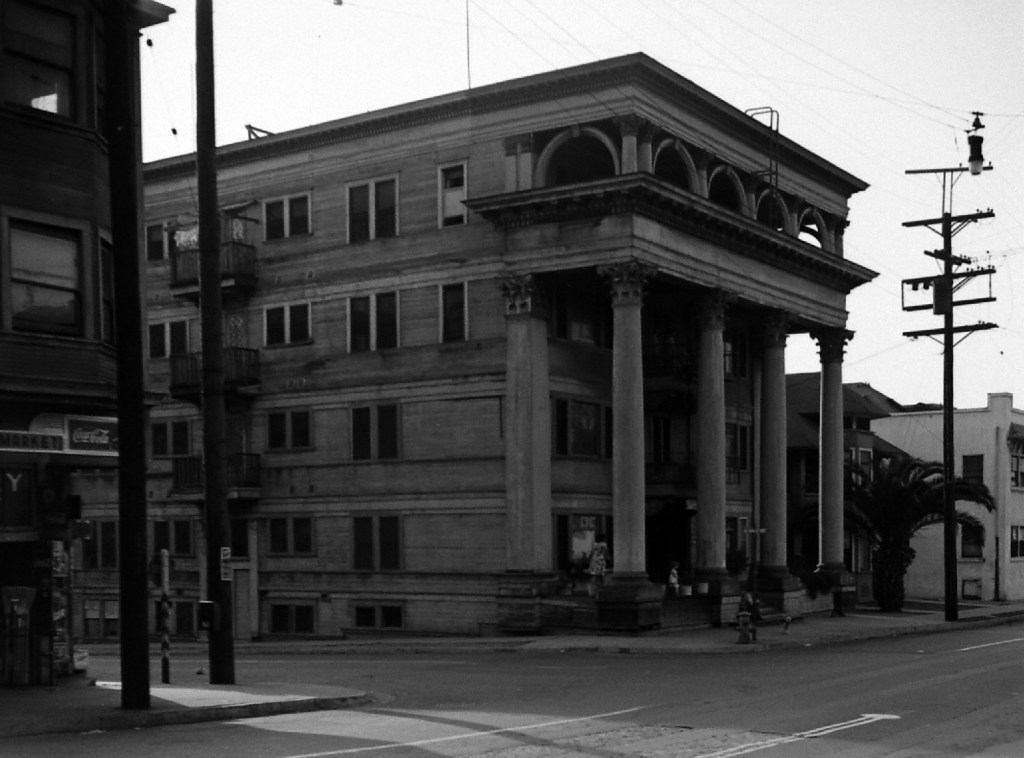
The Majestic, AKA the Rossmere and the Lima Apartments, in a very dim capture. I’ll grant you it looks rather forlorn here, ugly by 1945 standards (moreso given the dreary lighting), but would we pronounce it so…today? I think it’s a rather remarkable building. It was shot by nearly everyone, from Dickerson in its early days to Palmer Conner and George Mann near the end; I wrote about it here (and here) and it gets a full-page spread in Bunker Hill, Los Angeles.
The Melrose and Richelieu, 130-142 South Grand Avenue

Sanders shot a pair of images of the Melrose, and one of the Richelieu, and this one of the two together. I mean, you’ve probably had enough of these characters after reading this. Now, I haven’t actually gone through all fifty-two issues of LIFE from 1946 to find this purported “Ugly America” article, but seriously, if you have that issue, shoot me some shots of it, because I’m dying to read the copy.

First Street, between Olive and Grand
Historically less photographed is that part of the world around First Street, between Olive and Grand, where Sanders took a few shots—

Above, the southwest corner of First and Olive (with the Mission-Revival Owens Apartments at 502 West First, in all its parapet’d and tile-towered glory), First Street running west up the right side of the image, shot from the towering dirt hill kittycorner.
From the same vantage point, at the opposite (northwest) corner:
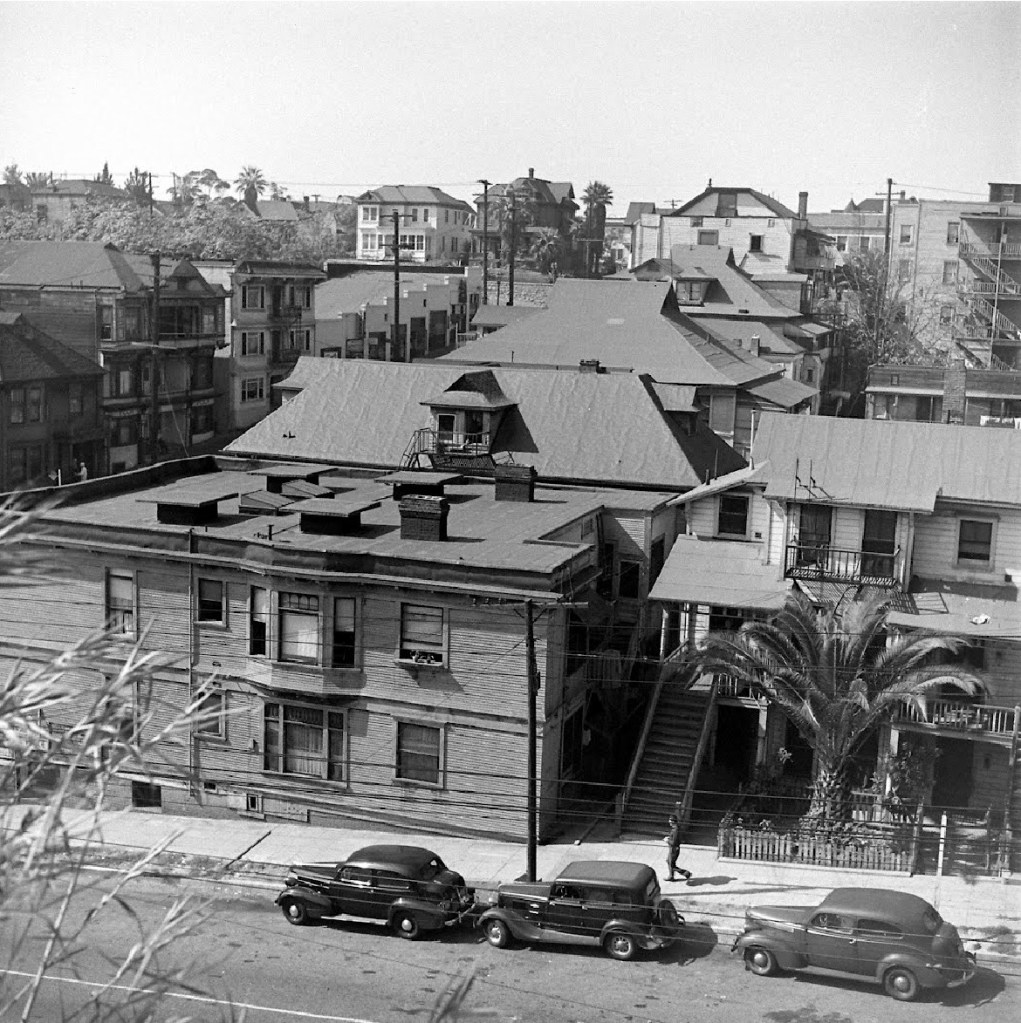
The structure at bottom left in the above image is 501 West First (with 107 North Olive to its right). 501 West First shows up again:

Six years later, in October 1951, the Examiner shot that same corner when a Deputy Sheriff careened out of control and smashed into that callbox:

Sanders also shot the Nolen Apartments at 512 West First, mid-way up the block on the south side (it can be seen at left in both images taken from the hill)—
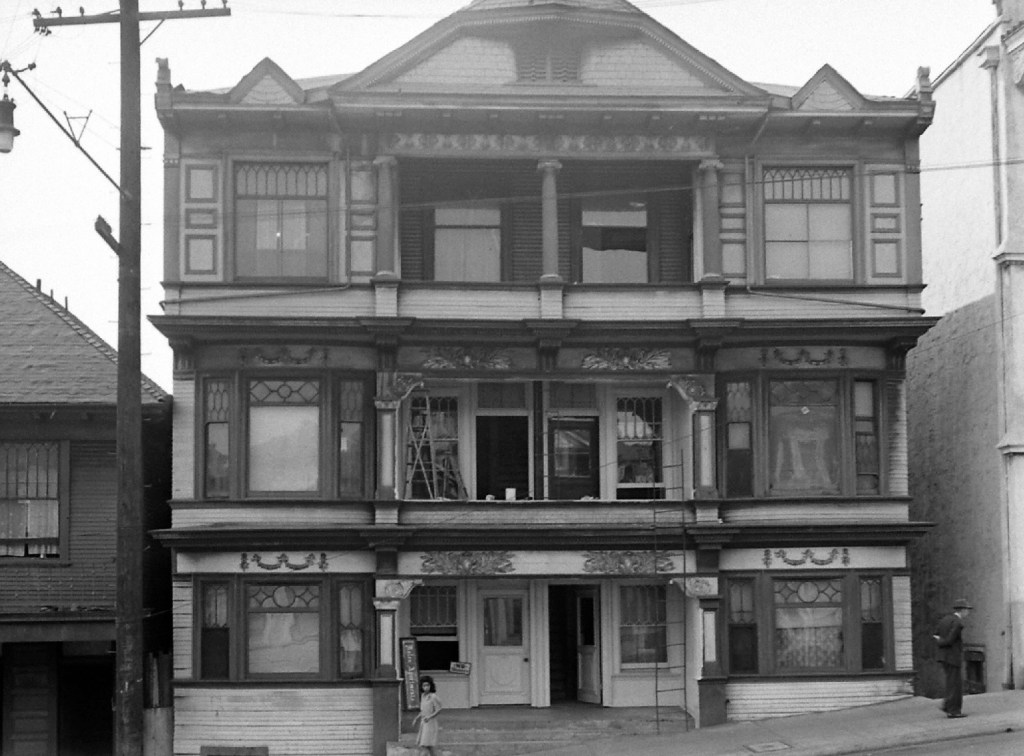
Below, we look down First from Grand, with the aforementioned hill in the distance, whence he shot the intersection of First and Olive:
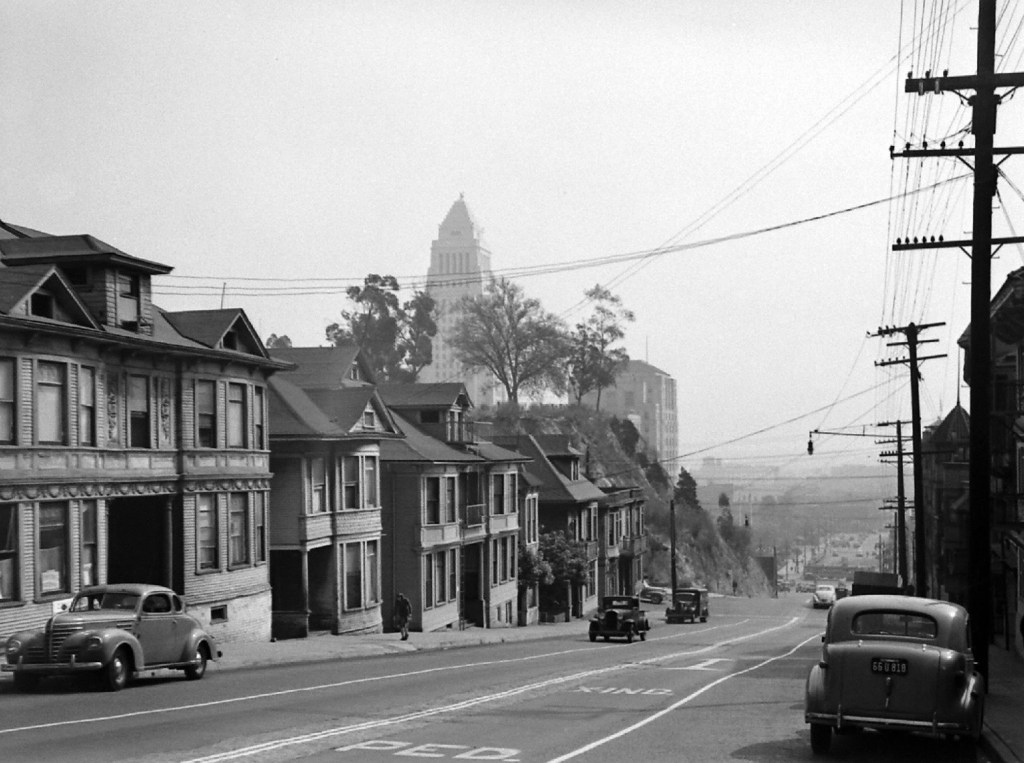
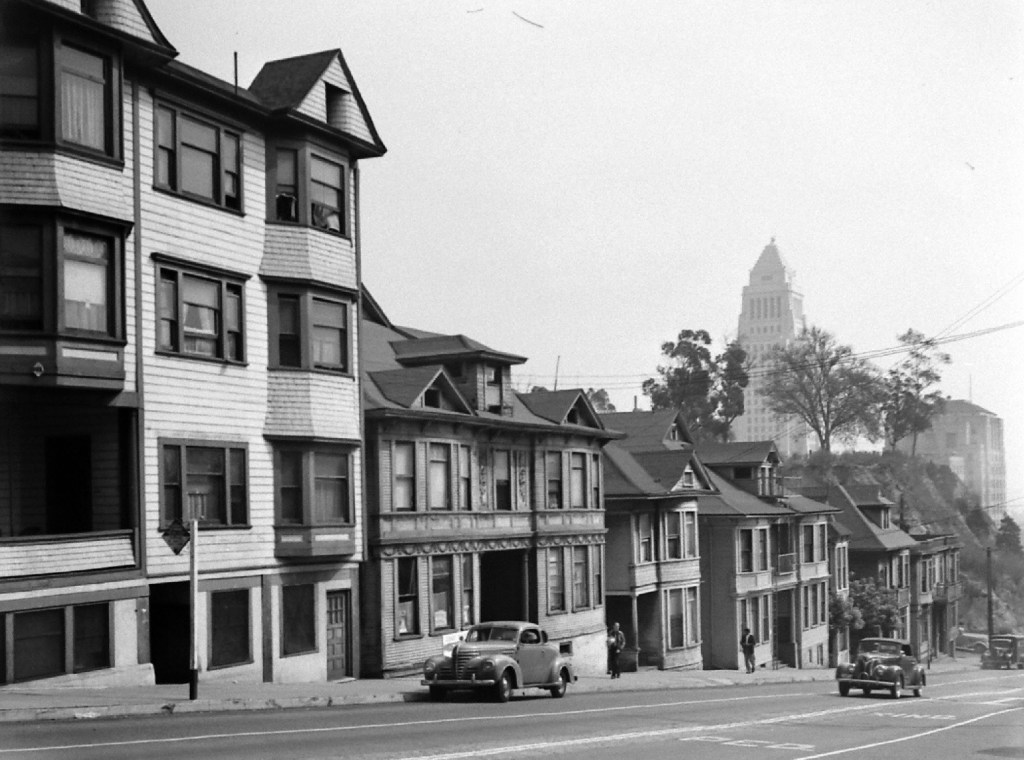
The structure second from left, above, is 519/521 West First:
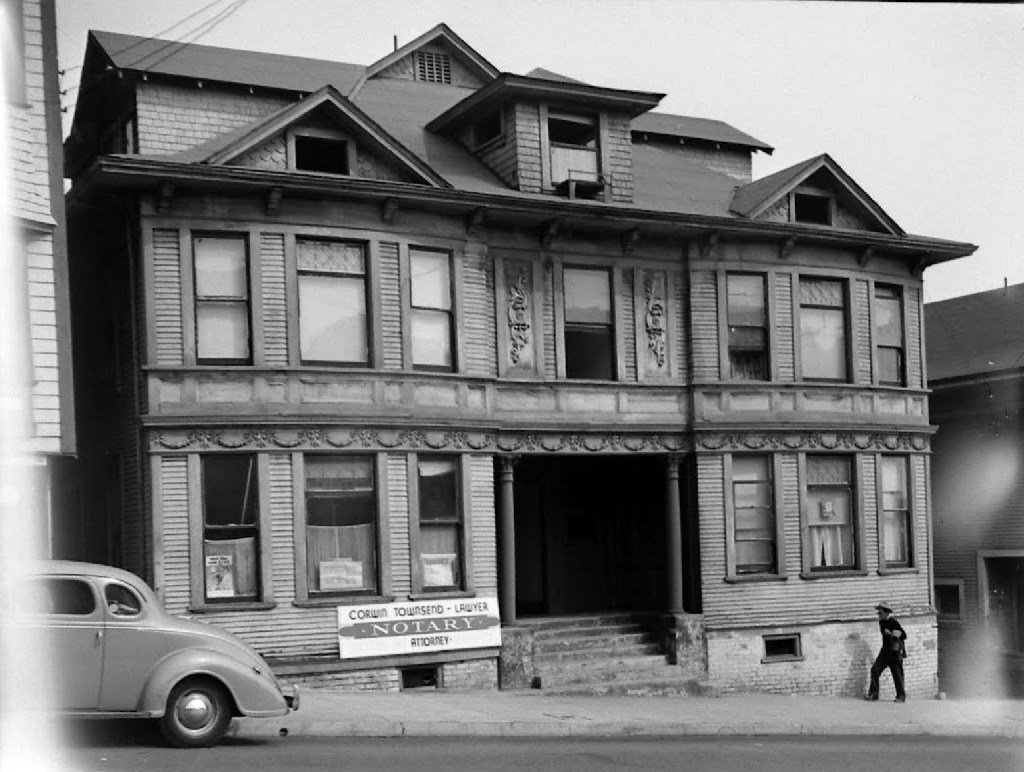
The Queen Apartments—529 California Street
The Queen makes its appearance in BHLA, of course, but it’s the straight-ahead shot we’re used to seeing (in online magazine articles, for example). What makes Sanders’ shots different are his standing further back, and shooting a wide shot from up the street:
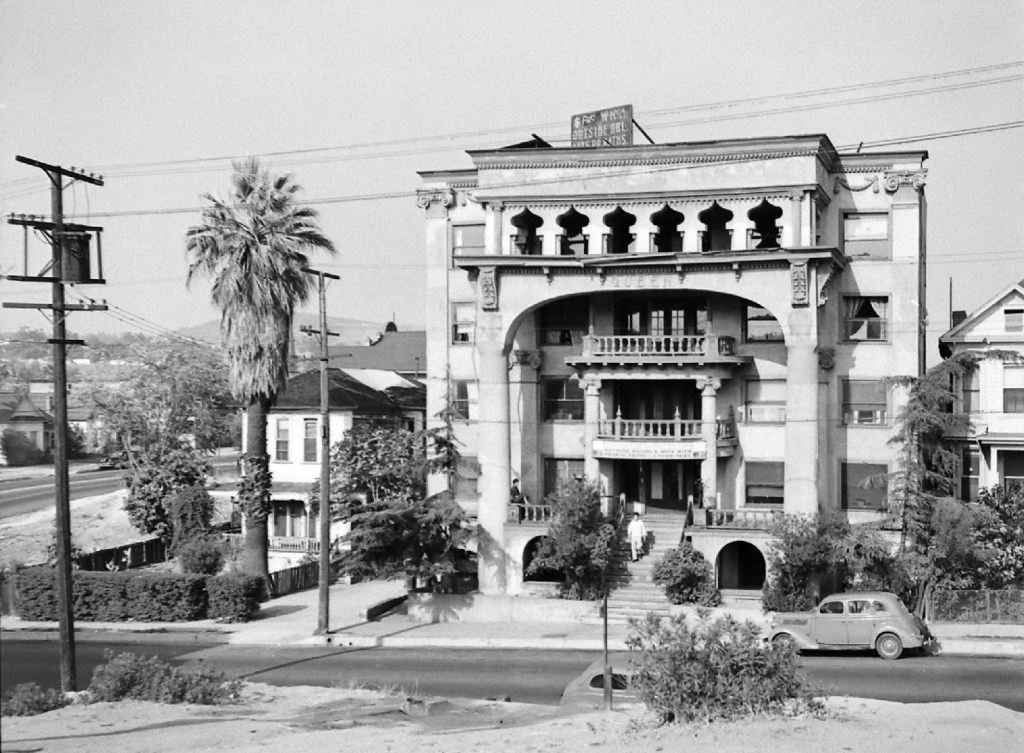

The Weygand Apartments, 208 South Figueroa
You may be familiar with the wonderfully Neoclassical/Greek Revival Weygrand at 208 South Figueroa from this 1964 shot by William Reagh. Really nice to see this oblique angle from 1945:

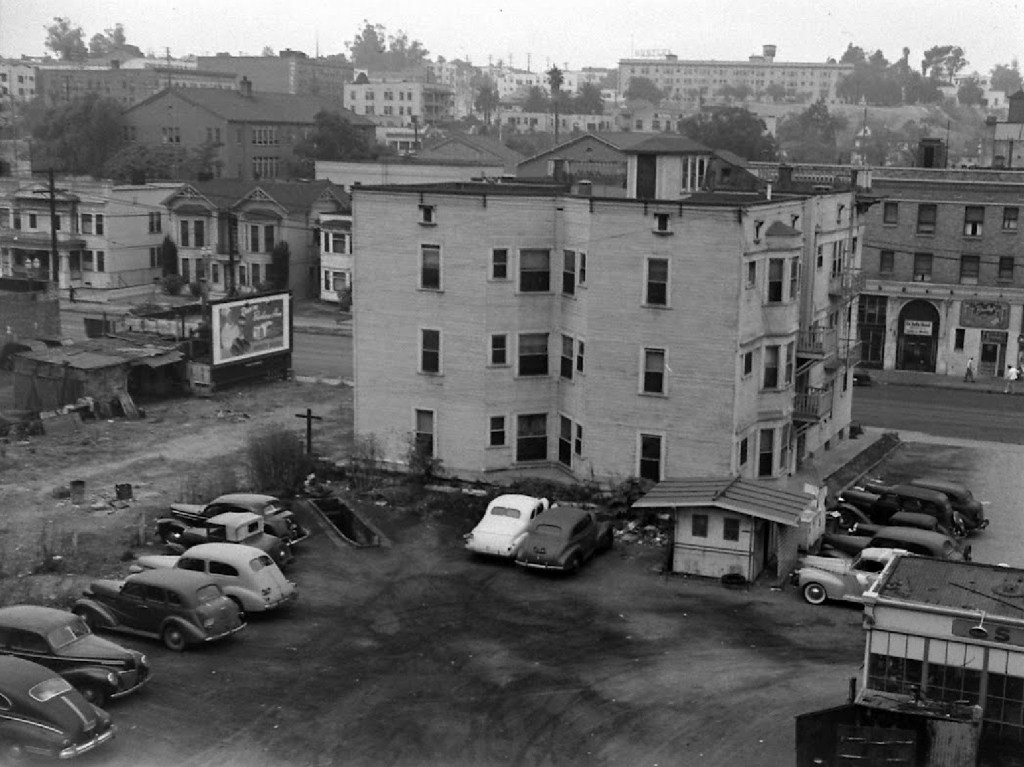
Above, a shot of the back of The Weygrand, taken by Sanders while standing at the railing of the Second Street tunnel at Flower. A bit like this Nadel image from 1955, which Nadel shot from the Stanley Hotel.
J. P. Miller house–201 South Bunker Hill Avenue
The Miller (seen here in 1896) house is not the most unphotographed house on the Hill, shot as it was, and in color, by George Mann and Walker Evans. Still, I like this image, as it predates those two by fifteen years or so, and shows all sorts of interesting differences (like the loss of the upper railing and those ball-top newels, the enclosure of the back porch, etc).
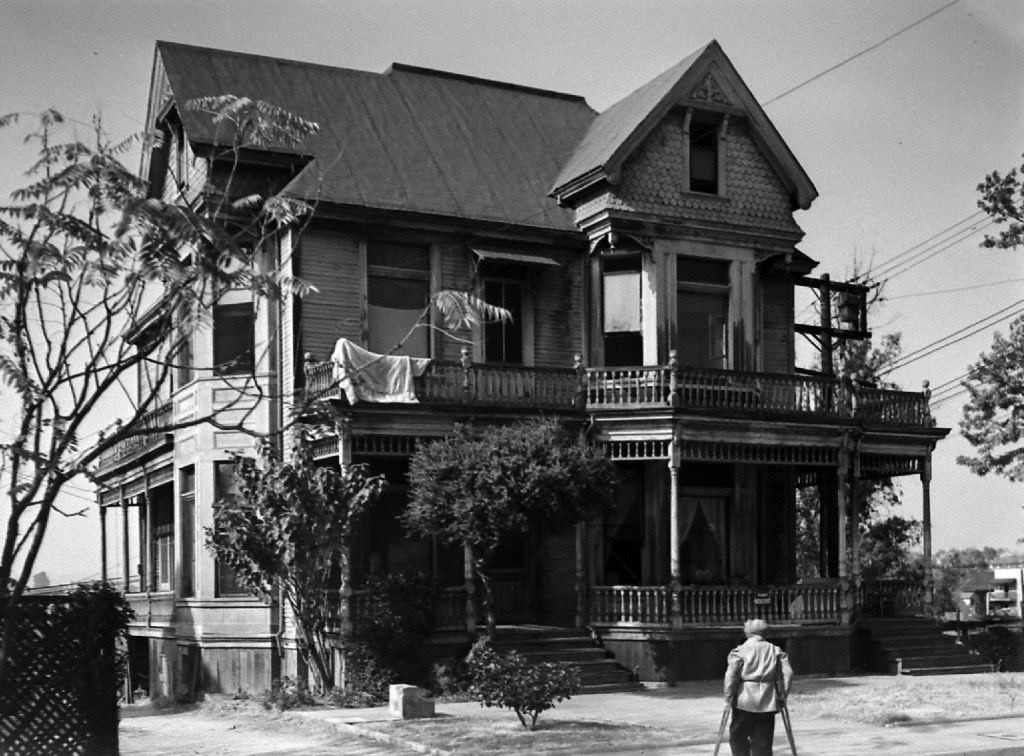
Sanders also shot up at the back of the house from Second and Hope Streets:

Berke Mansion—145 South Bunker Hill Ave.
While standing on Second between Bunker Hill Ave and Hope Street, Sanders turned his camera to the Berke, which loomed o’er.

The Backyards of Olive Street
In images worthy of Leonard Nadel, Sanders, standing on the dirt incline near the back of the Melrose, captured the cluttered back yards of the 100 block of South Olive.
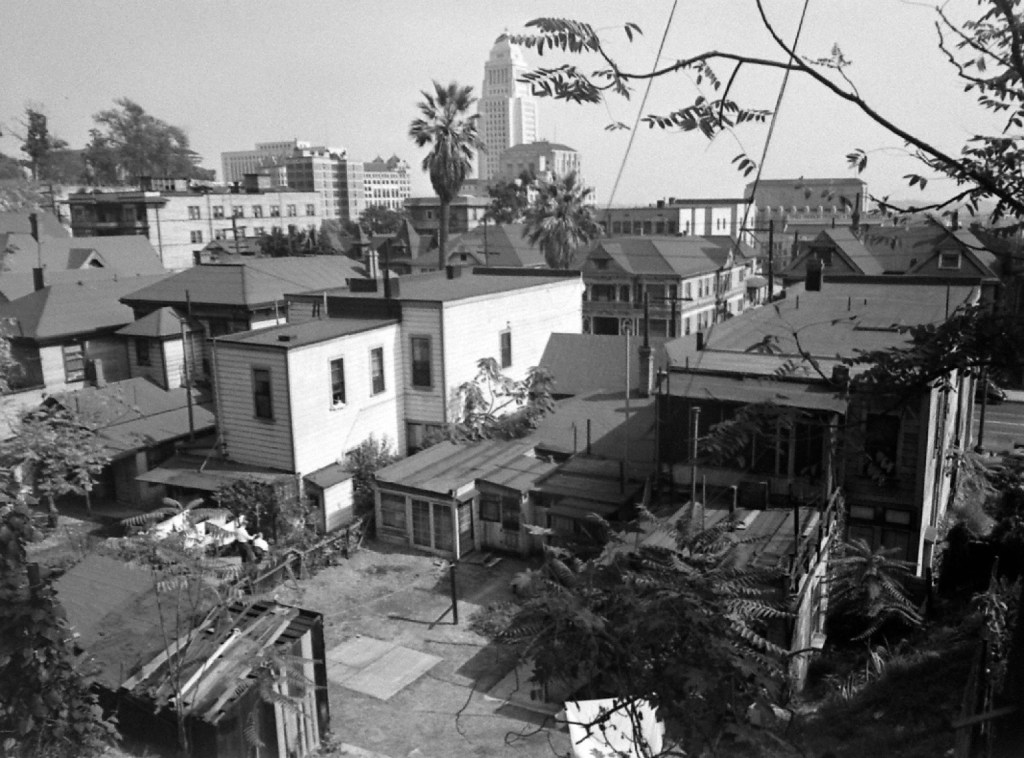

The white structure, center, 129 South Olive, gets a shot of itself in the book:
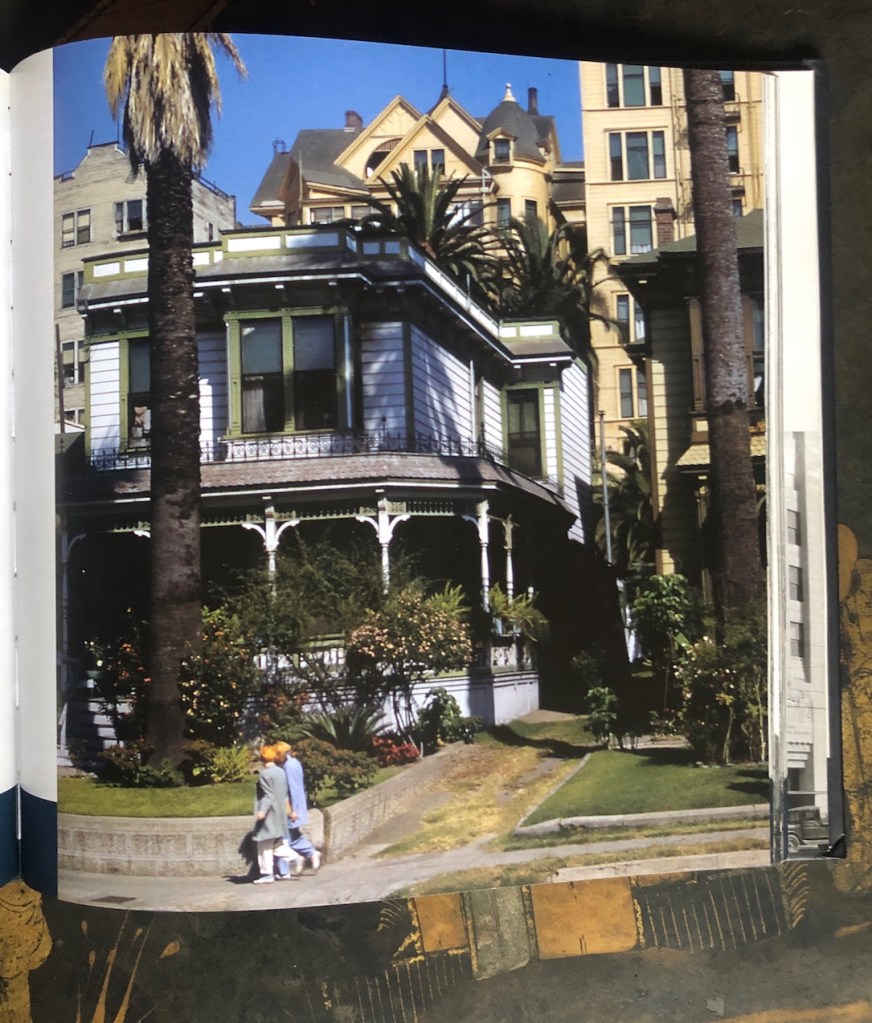
The Gibson—635 West Fourth Street
Now we’re getting into some meaty meat. The Gibson at Fourth and Hope is one of my favorite structures:

Zelda Best Keel had married Fred Gibson in Ohio in 1898; they came to Los Angeles and built the Gibson, at 635 West Fourth St., designed by Zelda’s brother Jesse Reece Keel, in the fall of 1903. She then married Harvey La Chat in April 1907 and they built the Zelda in 1908, also designed and built by the J. R. Keel & Co. She, her brother and their families all lived and died in the Zelda, though they, perhaps fortunately, did not live to see its end. The widening of Fourth Street for the freeway cut took out both the Gibson and Zelda, in the summer of 1954.
Shots of the Gibson are few and far between, so I was immensely gratified to be rewarded with this one:
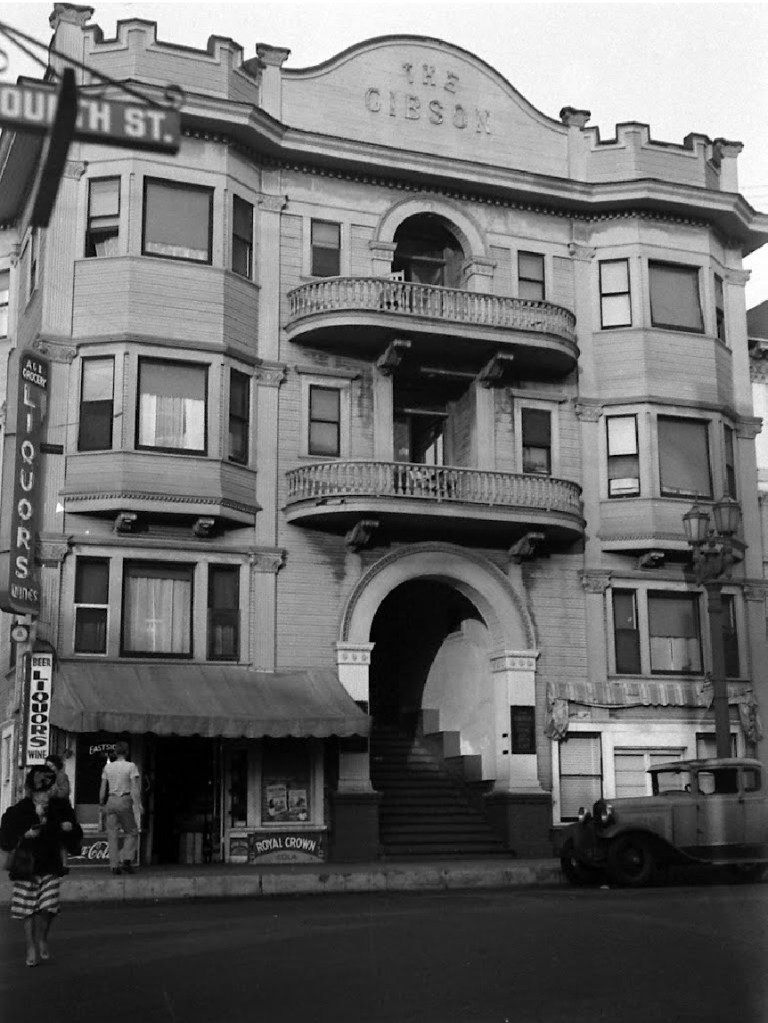
I mean, notice how the humble Edwardian-era grocery became the world’s most noir liquor store.
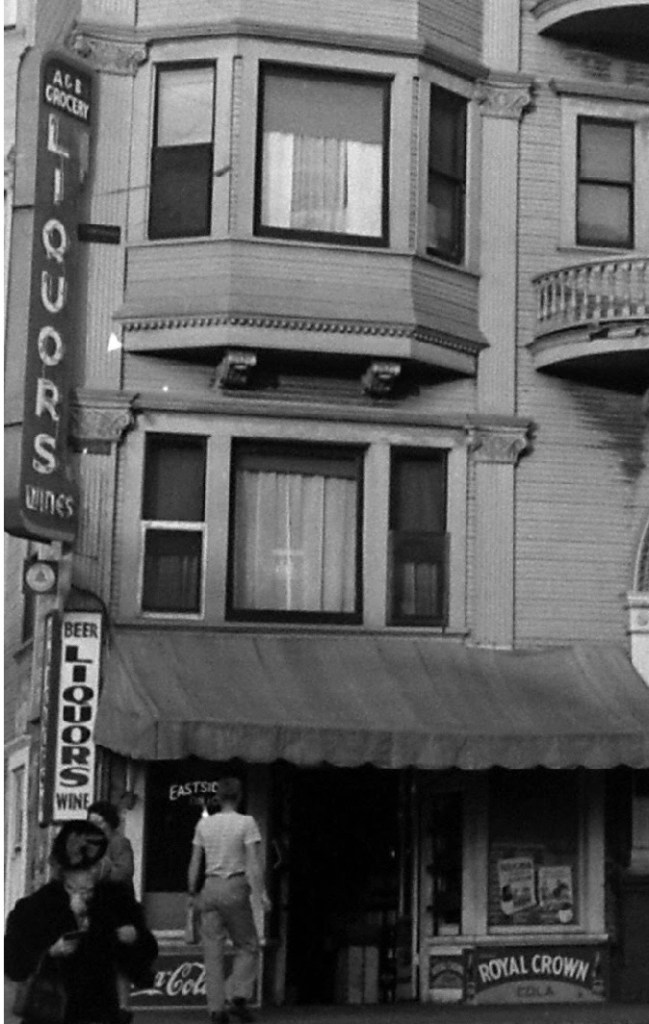
The Francis—129 South Grand/128 South Bunker Hill Avenue
In 1905, Mrs. Fannie Mansfield, widow of Francis Mansfield, engaged architect Arthur L. Haley to built and apartment building between First and Second, that ran from Grand to Bunker Hill Avenue. It was to be known as the Mansfield, but she soon changed its name to the Francis.
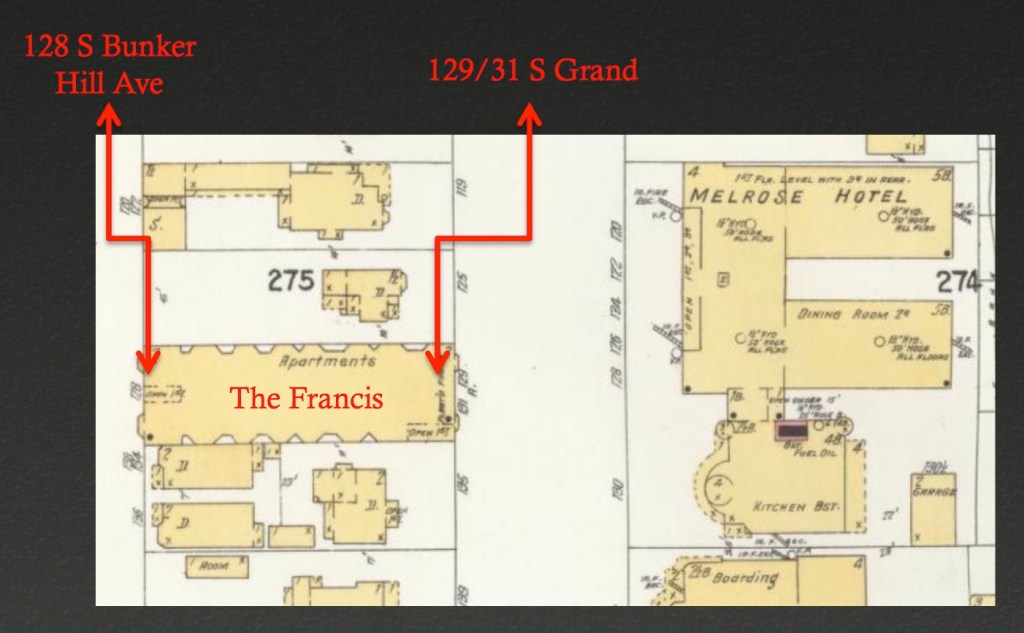
I’ve only found one proper image of the 131-129 S Grand Avenue frontage, which has its entrance on the south corner of its subtly asymmetrical, plastered, Mission Revival façade:

But have you ever seen the Bunker Hill Avenue side? That one is all bilateral symmetry, and covered in traditional shiplap:

And you may say, well, yes, Nathan, there’s an image of the Francis’ 128 South Bunker Hill side in the Palmer Conner collection:

To which I say not good enough! You can’t even see the quatrefoil! But:

Those then are the Bunker Hill images from Sanders’ November 1945 trip out west; remember, though, they account for about only 10% of the shots from this set. As I mentioned before, Sanders went to other parts of Los Angeles, and up to San Francisco, in his search for Ugly. Some quick examples:
LOS ANGELES


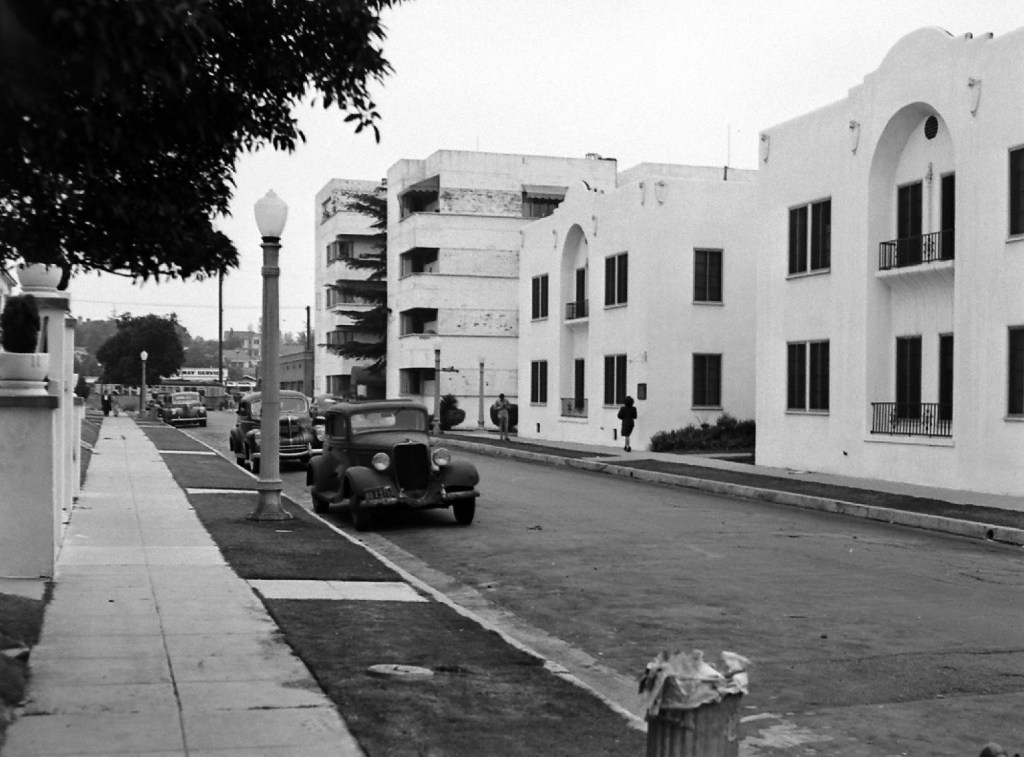
SAN FRANCISCO

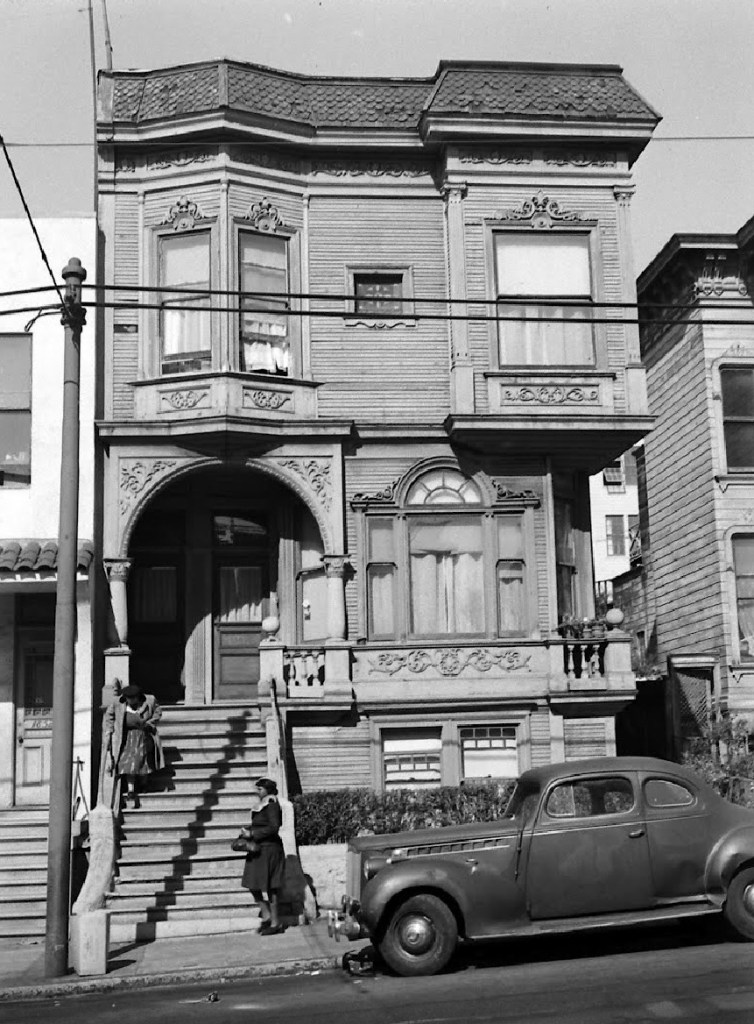

It’s fascinating to get a glimpse into what was considered ugly in 1945, and how that fit into greater cultural prejudices against old buildings (I go into this a bit on p. 64 of BHLA—e.g., the 1941 play/1944 movie Arsenic and Old Lace, in which we learn to stay away from the Victorian house on our block, as it is likely inhabited by psychopathic, poisoning spinsters). One wonders how Sanders, who lived till 1985, felt about his role as a documentarian come the early 1960s, when the Bunker Hill streets he walked in 1945 were depopulated and demolished.
Compare the 1945 LIFE shoot with one from eighteen years later titled “Doomed…It Must Be Saved” in which Walker Evans shot Bunker Hill. That feature described a great number of buildings America could not afford to lose…of course, the 1963 LIFE feature didn’t look kindly on anything as recent as fifty-year-old buildings, just as the 1945 feature looked upon fifty-year-old buildings with a jaundiced eye.
Of course, today, on post-redevelopment Bunker Hill, things aren’t looking so hot for fifty-year-old buildings, either. We’re just hitting that sweet spot when building owners really like messing with their properties.
We’ve seen this recently, when KBS Realty built up the south half of the 1965 Union Bank Plaza. Yes, the majority of the Eckbo gardens at the north half were spared, but only after a fight (then, after KBS’s $20-million renovation, they promptly turned around and sold the property…for a $50-million loss).
We’ve seen this recently, at the 1968 Bunker Hill Towers, which had balconies stuck on and were then painted battleship grey.
We’re seeing this now, as the 1974 Sasaki-Walker designed park at the Security Pacific plaza will soon have a 366-unit tower covering the southeast corner.
We’re seeing this now, as the 1975 World Trade Center will have a skyscraper attached; it’s unclear whether its intact 1970s lobby with 1000′ foot-long Tony Sheets bas relief The History of World Commerce will survive the build.
In any event, those then are the Hill shots captured by Sanders in 1945. Thank you for reading! And as I continue to uncover new (to me) Bunker Hill images, I shall endeavor to bring them to you here.
Nathan- Thank you for the pleasant afternoon I just spent viewing your post and following all the informative links. And thanks for another good job bringing this material to our attention and fleshing it out with context. I am reminded of what I have said before about Nadel’s and now Sanders’ photos. These buildings were never meant to be viewed from behind. A great deal of work was spent in design and construction to present their best face toward the street. It would be like going for portrait photograph only to be told by the photographer, “Oh, no,no,no. Turn around, now, bend over. That’s the view I want.”
LikeLiked by 2 people
Exactly!
LikeLike
Thank you for posting the images. I have a question. What was the highest point of Bunker Hill? Was it Bunker Hill Avenue and 1st Street?
LikeLiked by 1 person
The highest part of Bunker Hill was the 300 block of S. Bunker Hill Ave, the location of the Castle.
LikeLiked by 2 people
What a terrific post, Nathan!Thank you so much for your tireless digging.Leslie
LikeLiked by 1 person
Touche Nathan— This “hunt” feels like when I collected postage stamps as a lad –when I could finally complete a set of stamps from wherever — Um- The name Allison Apts was found (in one of the crumbling city directories at 129 S. Grand) when I pored thru the ones at LAPL Central – probably 1940s..
LikeLiked by 1 person
That’s right! In fact that happened pretty early. Between the 1910 and the 1914 Baist Real Estate Atlas, it changed its name:
LikeLike
Oh my gosh, thank you for pinpointing these (and for the shoutout). I hadn’t put more up on Instagram yet because I was trying to figure out locations and this has answered a lot of questions for me. The SF ones really threw me.
Interestingly, the “Ugly America” shots were not just limited to Sanders. Removing Sanders’ name, the “Ugly America” title also features Long Beach / Signal Hill images by Andreas Feininger, and then a lot of east coast images from Margaret Bourke White, so I do wonder what the magazine had originally planned.
LikeLiked by 1 person
So, with further digging into the LIFE files, I see that the Margaret Bourke White “Ugly America” shots were published June 27, 1938 in a piece on “highway clutter” ‘ruining’ the views of east coast highways, with pictures of signage and billboards captioned “Eyesores”
Ten years and one week later, on July 5, 1948, LIFE published Feininger’s oilfield photos that they have catalogued as “Ugly America” in a story that they titled “Man-Made Landscapes: Americans Have Changed the Face of the West.” That story features six pages on Los Angeles (in three two-page sections) that could be summarized as ‘isn’t a shame there are highways,’ ‘people went west hearing stories of beauty and nature, with palm trees growing everywhere, but then they ruined it by placing houses together with manufactured lawns and hedges.’ and ‘too many oil derricks!’ It also includes a complaint of the amount of power lines being stretched across the desert from Hoover Dam, and then photos of the rushed ‘war town’ in Vallejo that look so identical to Sanders’ shots that I’m wondering if they’re misfiled.
Anyway, I think we can conclude that Sanders had been assigned to gather material for this story, but that his photographs were not used. Clearly there are some ‘negative’ images in his set, including the empty wasteland-y lots filled with trash and the abandoned car (and one even has a bed sitting on the sidewalk), but then there are a lot of more interesting if not beautiful shots in the collection as well. That suggests to me that they are either the result of the broader sweep, meaning that he just snapped away on the same rolls of film, taking pictures both of things he loved and things he hated, and that they all got compiled into the same files… or there’s something else in them that he was looking to emphasize. I want to double back to the Hoover Dam mention above, because the one thing that does really stand out to me about his Bunker Hill shots is that each of them has been framed in a way that showcases the power lines…
SO, if the article is proposing that power lines ruin the landscape, then my theory is that maybe Sanders set out to document them and prove that thesis, but that Bunker Hill had so much character that it muddied the focus so they dropped him from the assignment and handed it to Feininger. That at least makes some sense to me.
Here’s a link to the two LIFE stories mentioned:
1937: https://books.google.com/books?id=W08EAAAAMBAJ&pg=PA5&dq=bourke+white+highway&hl=en&sa=X&ved=2ahUKEwjk0Y_g68X8AhWhRzABHa7_A30Q6AF6BAgLEAI
1948: https://books.google.com/books?id=ekYEAAAAMBAJ&pg=PA63&dq=Feininger+oil&hl=en&sa=X&ved=2ahUKEwjt4pmG5cX8AhUxmmoFHb32DXAQ6AF6BAhmEAI
LikeLike
Great shots, Nathan. Keep ’em coming.
LikeLike